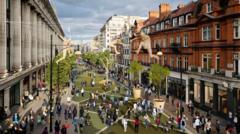Will the Mayor's Oxford Street Traffic Ban Transform the City?

Understanding the Oxford Street Pedestrianisation Plans: A Comprehensive Overview
As one of the most bustling shopping streets in the world, Oxford Street in London is set to undergo significant changes that could redefine its landscape. With plans to pedestrianise a substantial portion of this iconic street, London’s Mayor, Sir Sadiq Khan, has expressed urgency in moving these proposals forward. This article delves into the implications, challenges, and potential benefits of the pedestrianisation of Oxford Street, while also considering the various stakeholders involved in this transformative journey.
The Vision for Oxford Street
Oxford Street is renowned for its extensive retail offerings, attracting over half a million visitors daily. The vision for its pedestrianisation is to create a world-class avenue that prioritizes pedestrians over vehicles, enhancing the shopping experience while promoting leisure and outdoor events. Mayor Khan envisions this transformation as a means to rejuvenate the area, making it a global leader in shopping and leisure.
Current Plans and Proposals
The mayor's proposal includes banning vehicles from a 0.7-mile (1.1 km) stretch between Oxford Circus and Marble Arch. This initiative aims to create a safer and more inviting environment for pedestrians. Additional potential changes may extend towards Tottenham Court Road, showcasing a broader ambition to enhance urban mobility in the area.
Timeline for Implementation
City Hall has indicated that detailed proposals will be publicly consulted on later this year. This consultation phase is crucial for gathering feedback from various stakeholders, including local businesses, residents, and visitors. The feedback will help shape the final plans to ensure they meet the community's needs.
Community Support and Concerns
While City Hall claims that two-thirds of people support the idea of pedestrianising Oxford Street, the reality on the ground reveals a mixed bag of opinions. A previous consultation showed that support among local business owners and residents was notably lower compared to visitors. This divergence raises essential questions about the inclusiveness of the proposed changes.
Stakeholder Perspectives
- Local Businesses: Only 19% of local business owners expressed support for the pedestrianisation plan, indicating a level of concern about the potential impact on foot traffic and accessibility.
- Residents: Support among residents was even lower at 34%, suggesting that local concerns about traffic and accessibility need to be addressed comprehensively.
- Visitors: In contrast, 62% of visitors supported the initiative, highlighting a desire for a more pedestrian-friendly environment.
Challenges Ahead
Though the intention to pedestrianise Oxford Street is clear, several challenges loom large. Key stakeholders, including local councils and transport authorities, have raised critical questions about the feasibility of the plans.
Traffic Diversion Issues
Tim Lord, chair of the Soho Society, emphasized the need for a convincing plan regarding traffic diversion. The rerouting of 16 bus routes into narrow, congested one-way streets in areas like Marylebone and Fitzrovia poses significant logistical challenges. Such changes could exacerbate existing congestion and negatively impact the overall travel experience in central London.
Economic Concerns
Another significant challenge revolves around the retail environment on Oxford Street. Critics argue that the problems plaguing the street extend beyond traffic issues—factors such as high rents and the overall attractiveness of the retail offering are crucial. Many businesses have struggled to thrive under the current economic climate, leading to concerns about sustainability and viability in a pedestrianised environment.
Accessibility Considerations
Accessibility for all users is a paramount concern. Questions have been raised regarding how the pedestrianisation plans will accommodate various groups, including those with mobility restrictions, families with children, and individuals carrying heavy shopping. Ensuring equitable access to public transport and other modes of transportation is essential for the success of the initiative.
Feedback from the Community
Mr. Hug, Labour leader of Westminster City Council, emphasized the importance of collaboration to address these concerns. Following the mayor's new approach, there has been a focus on pragmatism and engagement with the Greater London Authority to refine the plans to better meet the needs of businesses, residents, and visitors alike.
The Political Landscape
The political dynamics surrounding the pedestrianisation of Oxford Street add another layer of complexity. The mayor’s proposals are contingent upon obtaining permission from the Deputy Prime Minister, Angela Rayner, to establish a new mayoral development corporation with planning powers. This legislative hurdle necessitates careful navigation of political relationships and public opinion.
Opposition Voices
City Hall Conservative Alessandro Georgiou AM has raised concerns about the mayor's approach, suggesting it undermines existing plans drawn up by Westminster Conservatives that had garnered public support. He has called for greater transparency regarding the potential impacts on congestion, public safety, and disabled access, as well as the financial implications of the proposed changes.
Potential Benefits of Pedestrianisation
Despite the challenges, the potential benefits of pedestrianising Oxford Street are substantial. A renewed focus on pedestrian spaces can lead to increased foot traffic, improved retail performance, and a more vibrant urban atmosphere.
Economic Revitalisation
As noted by Mr. Hug, Oxford Street has shown signs of recovery since the pandemic, with existing brands investing significantly in refurbishing their stores. A pedestrian-friendly environment could further enhance this revitalisation, attracting new businesses and investments, ultimately driving economic growth.
Enhanced Visitor Experience
Creating a pedestrianised Oxford Street could significantly elevate the visitor experience. A safer, more inviting environment for pedestrians could encourage longer stays and increased spending, benefiting local businesses and the economy as a whole.
Conclusion: The Future of Oxford Street
The plans to pedestrianise Oxford Street represent a bold step towards reimagining one of London's most iconic thoroughfares. While there are significant challenges to overcome, particularly regarding traffic management, accessibility, and community support, the potential benefits are immense. As consultations proceed, the voices of all stakeholders must be heard to create a balanced and inclusive plan that meets the needs of businesses, residents, and visitors alike.
As the city moves forward, the question remains: will the pedestrianisation of Oxford Street be a transformative success or a challenge fraught with complications? Only time will tell.
FAQs
What are the main objectives of the pedestrianisation plans for Oxford Street?
The main objectives include creating a safer environment for pedestrians, enhancing the shopping experience, and revitalising the area to attract more visitors and investment.
What are the main concerns regarding traffic management in the pedestrianisation plan?
Concerns include how 16 bus routes will be diverted to narrow streets, potentially increasing congestion and impacting travel times in surrounding areas.
How do local businesses feel about the pedestrianisation of Oxford Street?
Support among local business owners is relatively low, with only 19% expressing approval of the plans, indicating concerns about foot traffic and accessibility.
As London navigates these changes, how do you envision the future of urban spaces like Oxford Street? #OxfordStreet #UrbanRevitalization #Pedestrianisation
Published: 2025-06-17 10:23:17 | Category: technology



